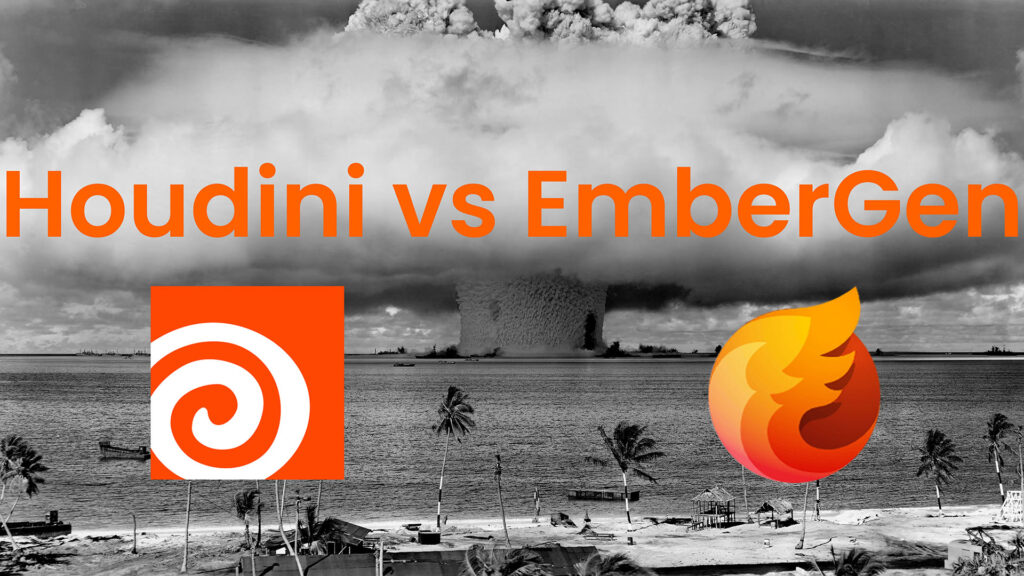EmberGen and Houdini are both highly regarded software tools in the visual effects and simulation industry. EmberGen is known for its real-time fluid simulation capabilities, while Houdini is known for its powerful and versatile features for creating visual effects, animations, and simulations.
Houdini
Houdini is a powerful and versatile software tool used in the film and gaming industries for creating visual effects, animations, and simulations. It is known for its ability to handle complex simulations, such as water and cloth, with ease, making it a highly sought-after tool for professionals in the industry. Houdini features a node-based interface, which allows for a high degree of control over simulations and provides a wide range of capabilities, including particle effects, rigid body simulations, and character animation. This makes Houdini an ideal choice for experienced artists who need a flexible and powerful solution for creating complex visual effects and simulations.
EmberGen
EmberGen is a real-time fluid simulation tool designed for creating fire, smoke, and explosion effects. It is known for its fast and intuitive workflow, which makes it easy for artists to quickly create high-quality effects. EmberGen is also capable of creating particles, fluid simulations, and 3D texturing, making it a versatile tool for a range of simulation needs. The user-friendly interface in EmberGen allows for easy access to its features and provides a straightforward solution for artists who want to quickly create real-time effects without the need for a complex workflow. Whether you are a professional artist looking for a reliable real-time simulation tool or a beginner looking to get started in the industry, EmberGen is a highly effective solution for your visual effects and simulation needs.
EmberGen vs Houdini

EmberGen is known for its fast and intuitive real-time simulation capabilities, while Houdini is renowned for its versatile features and node-based interface, ideal for creating complex visual effects. Both tools offer high-quality output and are reliable solutions for artists in the film and gaming industries. The choice between the two will depend on the artist’s specific needs, experience level, and type of effects they want to create.
When it comes to functionality, EmberGen is specifically designed for creating fire, smoke, and explosion effects in real-time, with a fast and intuitive workflow that makes it easy for artists to quickly produce high-quality results. On the other hand, Houdini offers a wide range of capabilities, including particle effects, rigid body simulations, and character animation, making it a versatile tool for handling complex simulations in various industries, such as film and gaming.
In terms of user interface, Houdini boasts a complex and powerful node-based interface, ideal for experienced artists who need a high degree of control over their simulations. EmberGen, on the other hand, has a more straightforward and user-friendly interface, making it accessible to artists who may not have as much experience with visual effects and simulation software.
When it comes to performance, EmberGen excels in real-time simulations, allowing artists to quickly preview and adjust their effects as they work. Houdini, while capable of handling larger and more complex simulations, may require more time for rendering.
When comparing EmberGen and Houdini, it’s important to consider their specific strengths and areas of focus. EmberGen is designed to provide fast and efficient real-time simulations, making it ideal for artists who need to quickly preview and adjust their effects as they work. On the other hand, Houdini’s node-based interface allows for a high degree of control over simulations, making it ideal for experienced artists who need to create complex and intricate effects.
In terms of output quality, both tools are capable of producing high-quality results, with Houdini offering more versatility in terms of the types of effects and simulations that can be created. However, the rendering times for Houdini may be longer compared to EmberGen, which is optimized for real-time simulations.
Overall, both EmberGen and Houdini offer unique features and capabilities for creating visual effects and simulations. The choice between the two will depend on the specific needs and experience level of the artist, as well as the type of effects they want to create. Whether you are a professional artist looking to create high-quality real-time simulations or a more experienced artist looking for a powerful and versatile tool, EmberGen and Houdini both offer reliable and effective solutions for visual effects and simulation creation.